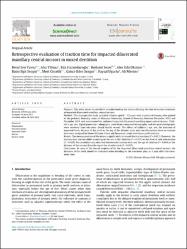| dc.contributor.author | Yavuz, Betül Şen | |
| dc.contributor.author | Yılmaz, Ahu | |
| dc.contributor.author | Haznedaroğlu, Eda | |
| dc.contributor.author | Sezer, Berkant | |
| dc.contributor.author | Okutan, Alev Eda | |
| dc.contributor.author | Sezgin, Batın Ilgıt | |
| dc.contributor.author | Özçelik, Mert | |
| dc.contributor.author | Sezgin, Gökçe İldeş | |
| dc.contributor.author | Uğurlu, Faysal | |
| dc.contributor.author | Menteş, Ali | |
| dc.date.accessioned | 2023-12-13T06:43:39Z | |
| dc.date.available | 2023-12-13T06:43:39Z | |
| dc.date.issued | 2023 | en_US |
| dc.identifier.citation | Yavuz, BŞ; Yılmaz, A; Haznedaroğlu, E; Sezer, B; Okutan, AE; Ilgıt, SB; Özçelik, M; Sezgin, Gİ; Uğurlu, F; Menteş, A. Retrospective evaluation of traction time for impacted dilacerated maxillary central incisors in mixed dentition . Journal of Stomatology, Oral and Maxillofacial Surgery (2023). 124(6). | en_US |
| dc.identifier.uri | https://hdl.handle.net/20.500.12900/241 | |
| dc.description.abstract | Purposes: This study aimed to contribute to understanding the factors affecting the time of traction treatment of impacted dilacerated maxillary central incisors. Methods: This retrospective study included children aged 8 - 11 years with a history of trauma, who applied to the pediatric dentistry clinics of Marmara University, School of Dentistry, between December 2013 and December 2019, and were treated for unilateral impacted dilacerated maxillary upper central incisors. Children's age, sex, digital panoramic radiographs, cone-beam computed tomography, and intraoral photographs were retrieved from electronic dental health records. The effects of children's age, sex, the direction of impacted teeth, distance of the teeth to the top of the alveolar crest, and root dilaceration level on traction time were analyzed by Mann-Whitney U test and Spearman's rank correlation coefficient test. Results: The inverse position of the incisors significantly increased the traction time (P = 0.012). However, the traction time did not differ according to the sex of the children (P = 0.707) or the level of root dilaceration (P = 0.429). No correlation was observed between the traction time and the age of children (P = 0.644) or the distance of the incisors from the top of the alveolar crest (P = 0.397). Conclusions: In cases of the forced eruption of for the impacted dilacerated maxillary central incisors, the direction of the teeth should be evaluated when deciding on the treatment plan, as it may affect the treatment time. & COPY; 2023 Elsevier Masson SAS. All rights reserved. | en_US |
| dc.language.iso | eng | en_US |
| dc.publisher | Elsevier | en_US |
| dc.relation.isversionof | 10.1016/j.jormas.2023.101485 | en_US |
| dc.rights | info:eu-repo/semantics/openAccess | en_US |
| dc.subject | Dilaserasyon | en_US |
| dc.subject | Dilaceration | en_US |
| dc.subject | Zorunlu patlama | en_US |
| dc.subject | Forced eruption | en_US |
| dc.subject | Gömülü diş | en_US |
| dc.subject | Impacted tooth | en_US |
| dc.subject | Kesici diş | en_US |
| dc.subject | Ters diş | en_US |
| dc.subject | Inverse tooth | en_US |
| dc.title | Retrospective evaluation of traction time for impacted dilacerated maxillary central incisors in mixed dentition | en_US |
| dc.type | article | en_US |
| dc.department | İstanbul Atlas Üniversitesi, Diş Hekimliği Fakültesi | en_US |
| dc.authorid | Alev Eda Okutan/ 0000-0001-9399-5761 | en_US |
| dc.contributor.institutionauthor | Okutan, Alev Eda | |
| dc.identifier.volume | 124 | en_US |
| dc.identifier.issue | 6 | en_US |
| dc.relation.journal | Journal of Stomatology, Oral and Maxillofacial Surgery | en_US |
| dc.relation.publicationcategory | Makale - Uluslararası Hakemli Dergi - Kurum Öğretim Elemanı | en_US |

















